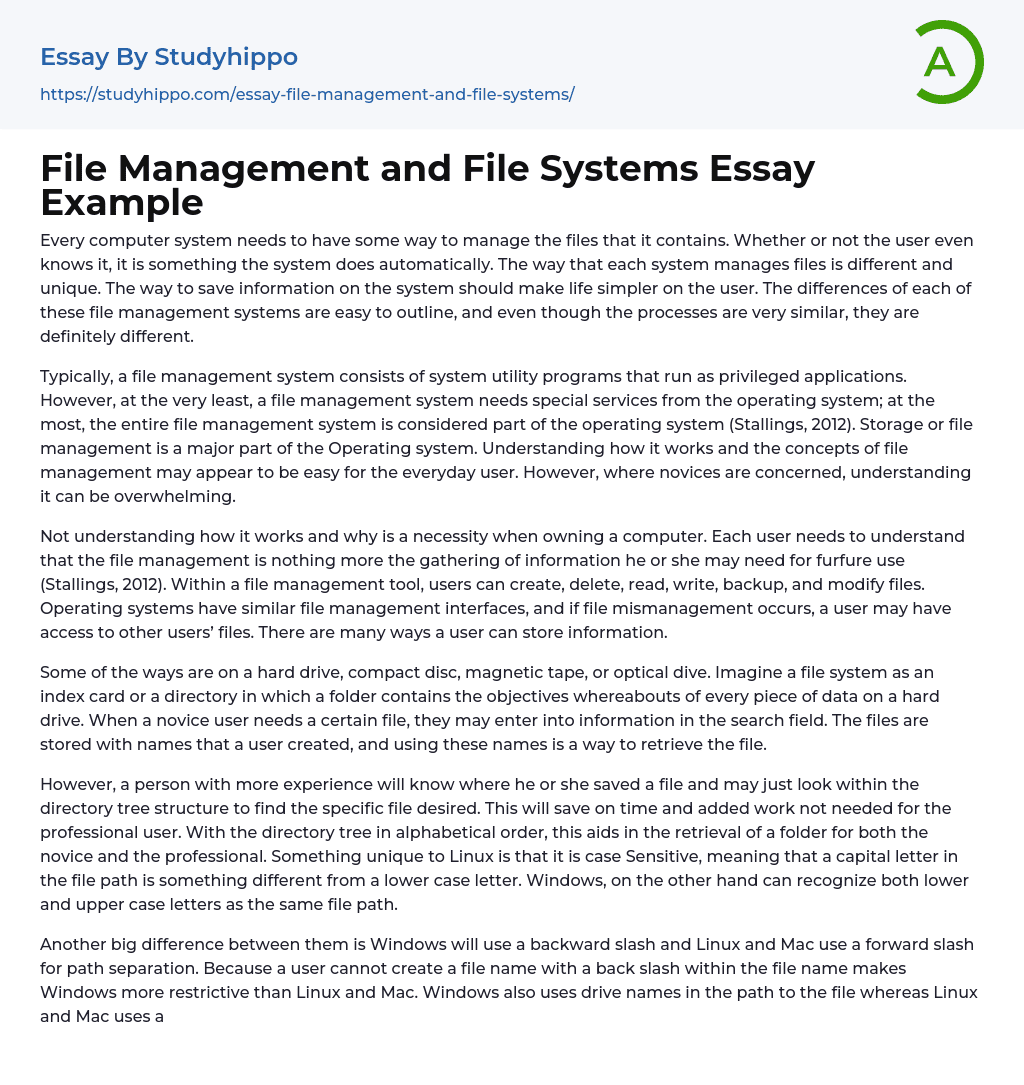Every computer system needs to have some way to manage the files that it contains. Whether or not the user even knows it, it is something the system does automatically. The way that each system manages files is different and unique. The way to save information on the system should make life simpler on the user. The differences of each of these file management systems are easy to outline, and even though the processes are very similar, they are definitely different.
Typically, a file management system consists of system utility programs that run as privileged applications. However, at the very least, a file management system needs special services from the operating system; at the most, the entire file management system is considered part of the operating system (Stallings, 2012). Storage or file management is a
...major part of the Operating system. Understanding how it works and the concepts of file management may appear to be easy for the everyday user. However, where novices are concerned, understanding it can be overwhelming.
Not understanding how it works and why is a necessity when owning a computer. Each user needs to understand that the file management is nothing more the gathering of information he or she may need for furfure use (Stallings, 2012). Within a file management tool, users can create, delete, read, write, backup, and modify files. Operating systems have similar file management interfaces, and if file mismanagement occurs, a user may have access to other users’ files. There are many ways a user can store information.
Some of the ways are on a hard drive, compact disc, magnetic tape, or optical
dive. Imagine a file system as an index card or a directory in which a folder contains the objectives whereabouts of every piece of data on a hard drive. When a novice user needs a certain file, they may enter into information in the search field. The files are stored with names that a user created, and using these names is a way to retrieve the file.
However, a person with more experience will know where he or she saved a file and may just look within the directory tree structure to find the specific file desired. This will save on time and added work not needed for the professional user. With the directory tree in alphabetical order, this aids in the retrieval of a folder for both the novice and the professional. Something unique to Linux is that it is case Sensitive, meaning that a capital letter in the file path is something different from a lower case letter. Windows, on the other hand can recognize both lower and upper case letters as the same file path.
Another big difference between them is Windows will use a backward slash and Linux and Mac use a forward slash for path separation. Because a user cannot create a file name with a back slash within the file name makes Windows more restrictive than Linux and Mac. Windows also uses drive names in the path to the file whereas Linux and Mac uses a similar item called mount points. Subsequently Windows is prone to fragmentation and Linux is not. The reason for that is Windows stores information entirely over its disk.
There always has been
a difference in file management between Windows and Mac. Recent versions of Windows use NTFS (New Technology File System). This system replaced the FAT (File Allocation Table) file system once in use in older versions of Windows and is still in use in Linux and UNIX. Mac uses a proprietary file system called HFS (Hierarchical File System). There are third-party products (e. g. , Parallels) available to allow access to Mac files on Windows and Windows files on a Mac. However, Apple products by design are limited for use only on Apple products.
This is one of the main reasons Windows has a larger market share over Apple. Mac uses web technology concerning file management. On a Mac information is stored in areas that pertain to it. An application file is stored in an application directory. Mac uses a system called finder or what is referred to as a B tree. HFS depends on a system of trees and nodes to recognize file locations on Mac. Because the user can have a file open on Mac, he or she can also rename or move an open file, unlike in Windows where an open file must be closed.
- Leadership and Management essays
- Change Management essays
- Project Management essays
- Knowledge Management essays
- Operations Management essays
- Quality Management essays
- Risk Management essays
- Scientific Management essays
- supply chain management essays
- Performance Management essays
- Time Management essays
- Brand Management essays
- Total Quality Management essays
- Risk essays
- Manager essays
- Leadership essays
- Business Ethics essays
- Board Of Directors essays
- Product Management essays
- Comparative Analysis essays
- Decision Making essays
- Dispute Resolution essays
- Stress Management essays
- Business Management essays
- Brand Equity essays
- Branding essays
- Nike, Inc. essays
- Market share essays
- Razor essays
- Being A Leader essays
- Servant Leadership essays
- Leadership Experience essays
- Leadership Qualities essays
- Incentive essays
- Computer File essays
- Desktop Computer essays
- Servers essays
- Data Management essays
- Enterprise Resource Planning essays
- File System essays
- Gsm essays
- Mobile device essays
- Steganography essays
- Accounting essays
- Andrew Carnegie essays
- Automation essays
- Business Cycle essays
- Business Intelligence essays
- Business Model essays
- Business Operations essays




